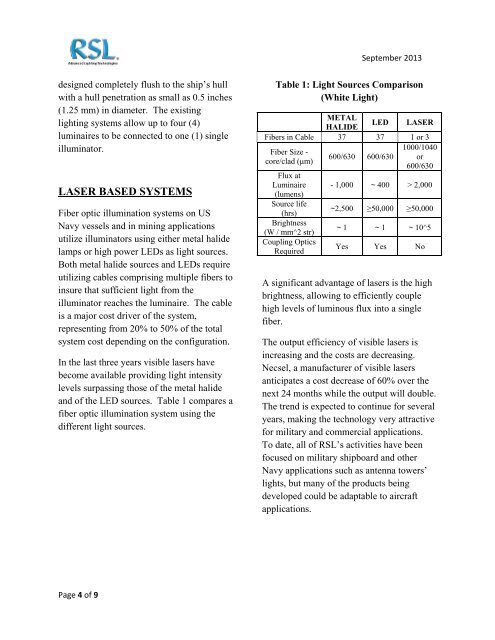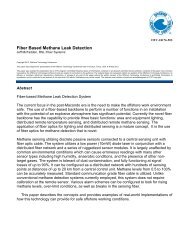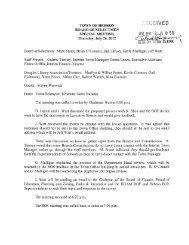Fiber Optic-based Lighting for Aircraft, Giovanni Tomasi, CEO/CTO ...
Fiber Optic-based Lighting for Aircraft, Giovanni Tomasi, CEO/CTO ...
Fiber Optic-based Lighting for Aircraft, Giovanni Tomasi, CEO/CTO ...
Create successful ePaper yourself
Turn your PDF publications into a flip-book with our unique Google optimized e-Paper software.
September 2013<br />
designed completely flush to the ship’s hull<br />
with a hull penetration as small as 0.5 inches<br />
(1.25 mm) in diameter. The existing<br />
lighting systems allow up to four (4)<br />
luminaires to be connected to one (1) single<br />
illuminator.<br />
LASER BASED SYSTEMS<br />
<strong>Fiber</strong> optic illumination systems on US<br />
Navy vessels and in mining applications<br />
utilize illuminators using either metal halide<br />
lamps or high power LEDs as light sources.<br />
Both metal halide sources and LEDs require<br />
utilizing cables comprising multiple fibers to<br />
insure that sufficient light from the<br />
illuminator reaches the luminaire. The cable<br />
is a major cost driver of the system,<br />
representing from 20% to 50% of the total<br />
system cost depending on the configuration.<br />
In the last three years visible lasers have<br />
become available providing light intensity<br />
levels surpassing those of the metal halide<br />
and of the LED sources. Table 1 compares a<br />
fiber optic illumination system using the<br />
different light sources.<br />
Table 1: Light Sources Comparison<br />
(White Light)<br />
METAL<br />
HALIDE<br />
LED LASER<br />
<strong>Fiber</strong>s in Cable 37 37 1 or 3<br />
1000/1040<br />
<strong>Fiber</strong> Size -<br />
600/630 600/630 or<br />
core/clad (μm)<br />
600/630<br />
Flux at<br />
Luminaire - 1,000 ~ 400 > 2,000<br />
(lumens)<br />
Source life<br />
(hrs)<br />
~2,500 ≥50,000 ≥50,000<br />
Brightness<br />
(W / mm^2 str)<br />
~ 1 ~ 1 ~ 10^5<br />
Coupling <strong>Optic</strong>s<br />
Required<br />
Yes Yes No<br />
A significant advantage of lasers is the high<br />
brightness, allowing to efficiently couple<br />
high levels of luminous flux into a single<br />
fiber.<br />
The output efficiency of visible lasers is<br />
increasing and the costs are decreasing.<br />
Necsel, a manufacturer of visible lasers<br />
anticipates a cost decrease of 60% over the<br />
next 24 months while the output will double.<br />
The trend is expected to continue <strong>for</strong> several<br />
years, making the technology very attractive<br />
<strong>for</strong> military and commercial applications.<br />
To date, all of RSL’s activities have been<br />
focused on military shipboard and other<br />
Navy applications such as antenna towers’<br />
lights, but many of the products being<br />
developed could be adaptable to aircraft<br />
applications.<br />
Page 4 of 9




